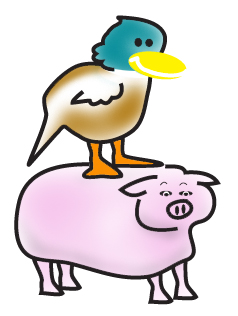 A pig walks into a bar with a duck
riding on his back. The bartender takes one look at the situation and says,
"Hey, no pets in here.”
A pig walks into a bar with a duck
riding on his back. The bartender takes one look at the situation and says,
"Hey, no pets in here.”
"He’s not a pet,” the duck says.
"He’s my Uber driver.”
"An Uber driver! Are you expecting
me to believe that a pig can drive a car?” the bartender replied.
"Sure would,” the duck said, "and
do you know why?”
"No I don’t,” said the bartender.
"Because you’re the one who
believes that ducks can talk.”
Knock, knock.
Who’s there?
Oink, oink!
Hey, did anyone call for a ride?
Why did the duck cross the road?
Because the pig had the wrong
address.
Last Monday was National Tell a
Joke Day. If there were a National Tell a Bad Joke Day, the above Duck
and Pig jokes might have qualified. Humor and marketing have long roots that
intertwine with each other. Why is that? Because funny things capture our
attention. We have a hard time separating ourselves from laughter. If someone
is watching some sort of media and starts to laugh, we want to see it too.
Anytime you have that kind of reaction, it is a marketing opportunity.
However, there is great difficulty
in doing humorous marketing. Humor is not easy to do because not everyone
laughs at the same jokes. Part of that is generational. The things my parents
thought were funny were not funny to me and vice versa. But part of it is the
times in which we live. We need to recognize a rather current cultural shift in
what people are laughing at - or I should say, not laughing at - these days. People are rather sensitive to
making light of anything that could be seen as a putdown of others (which is
why classic comedy of a decade or two ago has been condemned by the current
generation.) This is why a lot of brands have leaned away from humor in their
marketing. They are fearful that someone will be offended.
How do you make your marketing
funny without someone getting upset about it? One way to make your marketing humorous is to make it
absurd. The insurance company, Geico, has done that for years, like this
classic Hump Day ad. Now you may be saying, "that ad is funny, but it doesn’t
help sell insurance.” The main objective of that ad is not to instantly sell insurance,
it is to help you remember the brand name and the tagline: Geico, 15 minutes
could save you 15 percent or more on car insurance – which will sell you
insurance. The talking camel is a way to capture your attention so that you
recognize the brand and quickly understand what they can do for you. For
instance, as bad as my opening jokes were, it does set up an absurdity that, if
you are in on the joke, all I would have to do is send you a marketing message
that said "Oink, Quack!” and you would know exactly what I meant.Tie your
brand to that absurd message and you have a marketing campaign.
Are there pitfalls with this kind
of campaign? Certainly. You can cross the line of good taste and push the
stupid humor too far. But marketing is all about pushing the boundaries. There
is little that is off limits in advertising ridiculousness. The plain truth is
that, as preposterous as this type of marketing can be, it continues to capture
the attention of people. Whenever you have that kind of device, you should use
it.